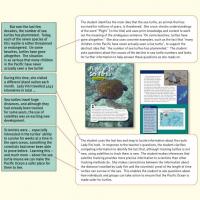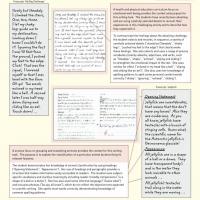By the end of year 5
The reading standard
The writing standard
The reading standard
By the end of year 5, students will read, respond to, and think critically about texts in order to meet the reading demands of The New Zealand Curriculum as they work towards level 3. Students will locate, evaluate, and integrate information and ideas within and across a small range of texts appropriate to this level as they generate and answer questions to meet specific learning purposes across the curriculum. The text and task demands of the curriculum are similar for students in year 5 and year 6. The difference in the standard for year 6 is the students’ increased accuracy and speed in reading a variety of texts from across the curriculum, their level of control and independence in selecting strategies for using texts to support their learning, and the range of texts they engage with. In particular, by the end of year 6, students will be required to read longer texts more quickly than students in year 5 and to be more effective in selecting different strategies for different reading purposes.
Key characteristics of texts that students read at this level
The texts that students use to meet the reading demands of the curriculum at this level will
often include:
- abstract ideas, in greater numbers than in texts at earlier levels, accompanied by concrete examples in the text that help support the students’ understanding
- some ideas and information that are conveyed indirectly and require students to infer by drawing on several related pieces of information in the text
- some information that is irrelevant to the identified purpose for reading (that is, some competing information), which students need to identify and reject as they integrate pieces of information in order to answer questions
- mixed text types (for example, a complex explanation may be included as part of a report)
- sentences that vary in length and in structure (for example, sentences that begin in different ways and different kinds of complex sentences with a number of subordinate clauses)
- a significant amount of vocabulary that is unfamiliar to the students (including academic and content-specific words and phrases), which is generally explained in the text by words or illustrations
- figurative and/or ambiguous language that the context helps students to understand
- illustrations, photographs, text boxes, diagrams, maps, charts, and graphs that clarify or extend the text and may require some interpretation.
Such texts will include both fiction and non-fiction in electronic and print media. They may be published individually, for example, as junior novels or information texts, or they may appear in collections, such as the School Journal or other journals and magazines for this age group. Such collections often include poems, plays, stories, and procedural texts.
Illustrating the reading standard
The student by the end of year 5 is guided in her use of strategies to understand the information and ideas in the text and to generate questions, related to her specific purpose for reading, within the science context.
'Plight of the Sea Turtle' (School Journal, Part 3 Number 2, 2008)
Noun frequency level: 10–12
By the end of year 5, students are required to use a variety of fiction and non-fiction texts to locate, evaluate, and integrate information and ideas in order to meet the reading demands of the curriculum, drawing on the knowledge, skills, and attitudes described for the end of year 5 in the Literacy Learning Progressions. The curriculum tasks will also involve the students in generating their own questions as well as answering questions from the teacher.
The students in a year 5 and 6 class are involved in a science investigation to discover how environmental causes and human actions have led to many animals becoming endangered and to identify a range of actions that individuals and organisations can take to restore the habitats of these endangered species.
'Plight of the Sea Turtle' deals with the decreasing numbers of sea turtles in the Pacific and describes some initiatives to prevent their extinction. The information is logically organised, and the text is well supported by photos, a map, captions, and easily identified information boxes.
The teacher chose 'Plight of the Sea Turtle' because the text includes a range of features, such as descriptive and explanatory text, factual information, and historical details. These require the students to find and use several pieces of information in order to ask and answer questions about this endangered animal.
This example illustrates aspects of the task and text and demonstrates how a student engages with both task and text to meet the reading demands of the curriculum. A number of such examples would be used to inform the overall teacher judgment for this student.
Return to top
The writing standard
By the end of year 5, students will create texts in order to meet the writing demands of the New Zealand Curriculum as they work towards level 3. Students will use their writing to think about, record, and communicate experiences, ideas, and information to meet specific learning purposes across the curriculum. The text and task demands of the curriculum are similar for students in year 5 and year 6. The difference in the standard for year 6 is the students’ increased accuracy and fluency in writing a variety of texts across the curriculum, their level of control and independence in selecting writing processes and strategies, and the range of texts they write. In particular, by the end of year 6, students will be required to write more complex texts than students in year 5 and to be more effective in selecting different strategies for different writing purposes.
Key characteristics of students' writing at this level
Students will write for a range of different purposes on topics and themes across the curriculum at this level, applying a process appropriate to the task and drawing on the knowledge, skills, and attitudes that will help them achieve their purpose. The knowledge, skills, and attitudes expected at this level, including those needed for spelling and punctuation, are described in the Literacy Learning Progressions.
Students will independently write texts, choosing language and overall text structures that are appropriate for their audience and purpose (for example, when recounting, describing, narrating, reporting, arguing, or explaining).
These texts will include, when appropriate:
- content that is usually relevant to the curriculum task and includes detail and/or comment supporting the main points
- paragraphs that group ideas
- simple and compound sentences that are correct grammatically and some complex sentences that are mostly correct grammatically
- words and phrases that are appropriate to the topic, register, and purpose, including subject-specific vocabulary.
Illustrating the writing standard
The students by the end of year 5 select appropriate details to communicate information and experiences relevant to the curriculum task.
‘My Big Challenge’ and ‘Jellyfish’
By the end of year 5, students are required to create a variety of texts in order to think about, record, and communicate experiences, ideas, and information across the curriculum. To meet the standard, students draw on the knowledge, skills, and attitudes for writing described in the Literacy Learning Progressions for students at this level.
These examples illustrate aspects of the tasks and texts and demonstrate how each student engages with both task and text to meet the writing demands of the curriculum. A number of such examples would be used to inform the overall teacher judgment for these students.
Published on: 19 Oct 2009
Return to top



